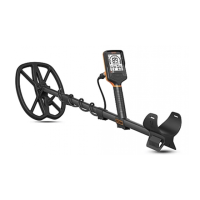8
Threshold:
With a Threshold funcon you will hear a constant audio signal in the
background. This is intended to help you hear the response from very small
targets that is produced by a piece of gold or other metallic specimen. Depending
on the type of headphones you are using, you may need to adjust the level of the
threshold sound you hear. You want to adjust it so that you can barely hear it yet
sll able to hear slight changes indicang a very small or deep target has been
detected.
Tones/Tone Spacing/Fesen:
While detecng, dierent targets will lead to dierent tones. Tone Spacing
determines at which target ID the detector starts to make a dierent tone. The
point between two dierent tones is called a tone break point. With Fesen you
can setup the volume of the tones when iron is detected.
Frequency shi:
Detectors and other electrical sources can interfere with your detector. With
operang a frequency shi you can change the frequency of your detector to
minimize the interference.
4. Explanaon of terms
Target ID (object idencaon):
The Target ID Arc shows segments, each one represenng several metal IDs. The
number in the middle shows the score of the currently detected object based on
its conducvity. The exact number varies depending on the characteriscs of the
ground, the size of the object, how deep it is buried, etc. Addionally, the tone of
the detector when idenfying a target varies in pitch depending on the target ID.
This overview will give you a rough idea which metal will score which metal ID
number:

